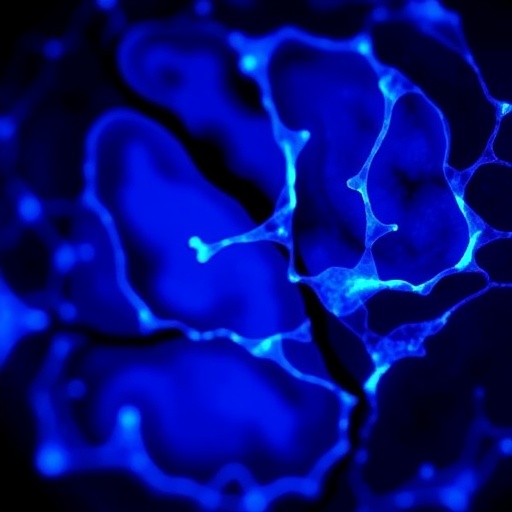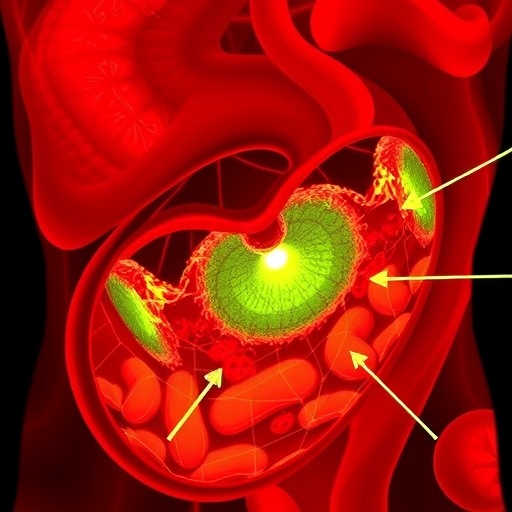In a significant leap forward for neuro-oncology, researchers have unveiled a comprehensive molecular atlas of central nervous system solitary fibrous tumors (CNS SFTs), offering unprecedented insights into their biology, classification, and exploitable therapeutic vulnerabilities. This groundbreaking study not only redefines the molecular taxonomy of these rare neoplasms but also lays the groundwork for targeted treatment strategies that could revolutionize patient outcomes. The investigation, spearheaded by Zhao, Hu, Guan, and colleagues, combines high-resolution genomic profiling with sophisticated bioinformatics to decode the enigmatic complexity of CNS SFTs, long shadowed by diagnostic ambiguities and limited therapeutic options.
Solitary fibrous tumors within the CNS represent a heterogeneous group of spindle cell neoplasms traditionally elusive to precise classification. Historically, their histopathological assessment suffered from overlapping features with other mesenchymal tumors, complicating diagnosis and treatment decisions. This ambiguity is now being addressed through integrative molecular analyses, which the authors have meticulously applied to a large cohort of CNS SFT patients. Armed with whole-genome sequencing, transcriptomic data, and methylation signatures, the researchers charted a molecular landscape that captures the intricacies of tumor evolution, highlighting distinct subtypes with discrete genetic and epigenetic alterations.
One of the study’s most compelling revelations lies in the delineation of discrete CNS SFT subtypes defined by specific chromosomal rearrangements and mutational profiles. The team identified hallmark NAB2-STAT6 gene fusions, previously recognized in extracranial SFTs, as a unifying genetic event across CNS variants but also uncovered novel fusion partners and secondary mutations that demarcate distinct biological behaviors. These molecular demarcations correlate with divergent clinical phenotypes, shedding light on the prognostic heterogeneity observed in patients. By mapping subtype-specific alterations, the study proposes a refined molecular classification system that surpasses traditional histology-based methods, promising to improve diagnostic accuracy and risk stratification.
.adsslot_3zCIZJRGTi{ width:728px !important; height:90px !important; }
@media (max-width:1199px) { .adsslot_3zCIZJRGTi{ width:468px !important; height:60px !important; } }
@media (max-width:767px) { .adsslot_3zCIZJRGTi{ width:320px !important; height:50px !important; } }
ADVERTISEMENT
Beyond classification, the authors ventured into exploring the therapeutic vulnerabilities intrinsic to the molecular architecture of CNS SFTs. Their integrative analyses revealed pathway dysregulations that sustain tumor growth and survival, providing rational targets for drug intervention. Notably, aberrant activation of angiogenic signaling cascades and aberrancies in cell cycle regulation emerged as recurrent features across subtypes. These findings offer a molecular rationale for employing anti-angiogenic agents and cell cycle modulators in tailored treatment regimens. Importantly, the identification of subtype-specific deregulated pathways hints at the potential for precision medicine approaches, thus moving beyond the one-size-fits-all paradigm that currently dominates clinical management.
The study also sheds light on the tumor microenvironment’s role in CNS SFT pathogenesis. Through transcriptomic deconvolution, the authors detected notable immune infiltration patterns that vary among molecular subgroups. These patterns encompass differences in immune effector cell types and checkpoint molecule expression, suggesting that the immune milieu could modulate tumor behavior and responsiveness to immunotherapies. Such insights herald new avenues for combining molecularly targeted therapies with immunomodulatory agents, potentially enhancing therapeutic efficacy and durability of response.
In a technical tour de force, the authors harnessed cutting-edge bioinformatics tools to integrate multi-omic datasets, enabling the construction of predictive models for tumor classification and outcome forecasting. Machine learning algorithms were trained using molecular features, resulting in classifiers capable of stratifying patients with high accuracy. This computational approach not only accelerates the translation of molecular findings into clinical practice but also exemplifies the growing synergy between artificial intelligence and oncology research. The methodology described paves the way for future studies aiming to personalize diagnostics and treatment based on molecular signatures.
The clinical implications of this research are multifold. Primarily, the refined molecular taxonomy equips clinicians with robust biomarkers to distinguish aggressive tumors from indolent forms, facilitating informed therapeutic decisions. Equally important, the elucidated therapeutic vulnerabilities pave the way for clinical trials evaluating targeted agents, potentially transforming the treatment landscape of CNS SFTs. Given the historically limited efficacy of conventional chemotherapy and radiation in these tumors, targeted interventions informed by molecular profiles promise to enhance survival outcomes and quality of life for affected patients.
Moreover, this work addresses a critical gap in CNS tumor research by focusing on solitary fibrous tumors, which have often been overshadowed by more prevalent gliomas in molecular studies. By placing CNS SFTs under the molecular microscope, the study underscores the importance of tumor-specific investigations that can unravel unique pathogenic mechanisms and therapeutic windows. The comprehensive molecular characterization serves as a blueprint for future endeavors aiming to decode other rare CNS neoplasms, advocating for integrative multi-omics as the gold standard in neuro-oncology research.
From a translational perspective, the authors highlight candidate molecular targets amenable to pharmacological modulation. The recurrent involvement of kinase pathways signals opportunities for drug repurposing or novel inhibitor design. Concurrently, epigenetic dysregulation identified in distinct subtypes opens possibilities for incorporating epigenetic therapies, which have gained traction in other malignancies. Such therapeutic innovation, inspired by deep molecular insights, could pivot clinical management towards personalized, mechanism-driven treatments rather than empirical regimens.
The study’s integrative design also provides a valuable resource for the scientific community. The assembled datasets, encompassing whole-genome, transcriptome, and methylome profiles, have been made accessible as a curated repository. This transparency promotes collaborative exploration, fostering hypothesis generation and cross-validation by diverse research groups. It also facilitates meta-analyses that may uncover conserved or context-specific tumor-driving mechanisms, accelerating the pace of discovery and therapeutic innovation in CNS oncology.
One particularly intriguing aspect of the research concerns the interplay between genetic alterations and epigenetic modifications. The authors observed that certain molecular subtypes exhibit distinct DNA methylation patterns that reinforce transcriptional dysregulation initiated by gene fusions or mutations. This epigenetic layering potentially stabilizes aberrant oncogenic programs, contributing to tumor maintenance and progression. Such findings emphasize the necessity of integrating epigenomic data when deciphering tumor biology and reinforce the complexity underlying therapeutic resistance. Interventions targeting these epigenetic regulators may provide new therapeutic inroads in recalcitrant cases.
Furthermore, the personalized models generated by the study optimize diagnostic workflows. Incorporating molecular classifiers alongside radiologic and histopathologic assessments could streamline diagnostic timelines, reduce misclassification, and inform risk-adapted monitoring strategies. The potential integration of these classifiers into routine pathology practice, possibly through digital pathology platforms enhanced with AI, signals a future wherein molecular precision drives every stage of tumor management from diagnosis to follow-up.
It is also worth noting the study’s emphasis on vascular biology within CNS SFTs. The elucidation of enhanced angiogenic signaling underscores how these tumors manipulate their microenvironment to secure nutrient delivery and evade immune surveillance. Anti-angiogenic therapies, already in use for other CNS tumors, may thus find a new application in these subtypes. The challenge remains in precisely targeting angiogenesis without inducing compensatory pathways, but the molecular insights provided spotlight promising checkpoints for intervention.
Lastly, the research exemplifies the critical synergy of interdisciplinary collaboration. It unites experts in neuropathology, genomics, bioinformatics, and clinical oncology to tackle a complex problem from multiple vantage points. This comprehensive approach, blending technological innovation with clinical acumen, exemplifies the future trajectory of cancer research—holistic, data-driven, and patient-centered. The legacy of this work will likely resonate in numerous subsequent investigations and, ultimately, in improved patient care paradigms.
As the field of neuro-oncology continues to evolve, this ambitious study marks a definitive milestone in understanding CNS solitary fibrous tumors. It challenges existing dogmas, carves out new conceptual frameworks, and ignites hope for tailored therapies in what was once a therapeutic frontier fraught with uncertainty. With further clinical translation and validation, the molecular stratification and therapeutic targets uncovered here promise to usher in an era of precision medicine that profoundly alters the prognosis for patients facing these enigmatic tumors.
Subject of Research: Molecular characterization, subtyping, and therapeutic vulnerabilities of central nervous system solitary fibrous tumors.
Article Title: Molecular landscape, subtypes, and therapeutic vulnerabilities of central nervous system solitary fibrous tumors.
Article References:
Zhao, C., Hu, X., Guan, X. et al. Molecular landscape, subtypes, and therapeutic vulnerabilities of central nervous system solitary fibrous tumors. Nat Commun 16, 7870 (2025). https://doi.org/10.1038/s41467-025-63039-4
Image Credits: AI Generated
Tags: bioinformatics in cancer researchcentral nervous system solitary fibrous tumorsdiagnosis of CNS neoplasmsepigenetic alterations in solitary fibrous tumorsgenetic profiling of solitary fibrous tumorshistopathological assessment of tumorsintegrative molecular analyses in oncologymolecular atlas of CNS SFTsneuro-oncology research advancementstargeted treatment strategies for CNS tumorstherapeutic vulnerabilities in CNS tumorstumor evolution and subtypes





